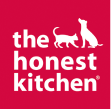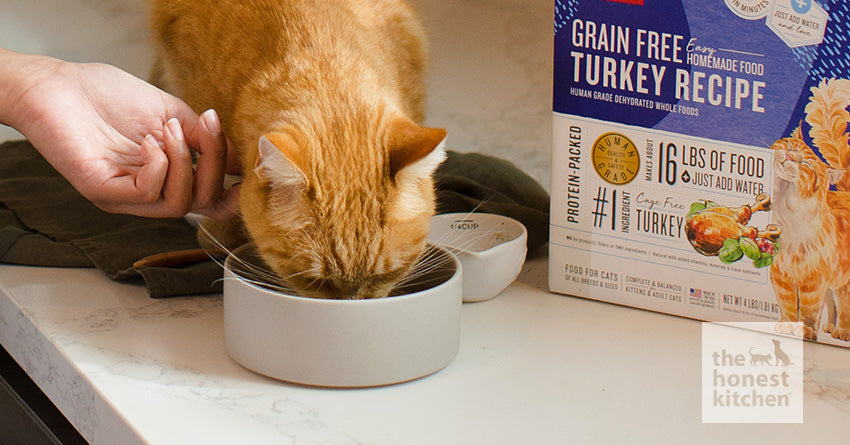Your cat relies on you for their nutritional well-being. As a cat owner, you know the importance of providing your cat with high-quality food. Yet many cat owners get confused by terms like grain-free, organic, by-products, etc.
With all the choices on the market, how can you determine what to feed your cat? One of the healthiest options available is human grade cat food, but even this term can be confusing when you start shopping for food. This guide will help you understand what "human grade" really means, and how you can choose high-quality food that supports your cat’s health and well-being.
Defining Human Grade Cat Food
For pet food to be called human grade, it must be made in a human food facility and meet the same standards as food manufactured for human consumption. It will use the same quality ingredients as food for human consumption, including fresh produce, whole grains, and quality meat.
The Association of American Feed Control Officials (AAFCO) is a voluntary organization of government agencies that focuses on the laws that control the regulation and distribution of food for animals in the United States. It warns pet owners that “human grade” is a claim with no official legal definition regarding pet food manufacturing. Thus, pet owners need to dig into the ingredients and manufacturing process when choosing a pet food, rather than being wowed by bold marketing claims alone.
AAFCO defines human grade pet food as having two distinct characteristics:
- All ingredients are human edible.
- The food is manufactured, packed, and held following FDA guidelines for safe food manufacturing.
If a food meets both of these claims, it is human grade. If it does not, then the label is incorrect. Though there are just two steps, both are important: If food has human edible ingredients but is processed in a facility that does not meet FDA guidelines for safe food handling, then the food cannot claim to be human grade.
The Honest Kitchen is the world’s first human grade pet food that carefully follows both aspects of this definition. With a strict quality assurance program and ingredients that are safe for human consumption, our cat food isn't just healthy — cats love the taste!
How the FDA Defines Human Grade
The FDA doesn't currently have regulations in place to define human grade pet food. It does, however, offer rules for human grade food that people consume, as does the USDA. For a pet food to truly be human grade, it must meet these guidelines.
According to the FDA, pet food must follow the regulations in FDA 21 CFR 110, Current Good Manufacturing Practice in Manufacturing, Packing or Holding Human Food in order to meet human grade requirements:
- Have ingredients that are safe for humans to eat at all times throughout the manufacturing process
- Make pet food in a USDA-inspected facility safe for human food
- Meet over 100 safety standards outlined in the regulation
Only when a pet food meets all of these criteria can it be labeled human grade. The safety standards outlined in FDA 21 CFR 110 are quite stringent, and it can be challenging for pet food manufacturers to follow them. This is why so few pet food brands can honestly claim that they're human grade, however, The Honest Kitchen was truly the first pet food manufacturer to follow these strict protocols to produce high-quality human grade pet food.
Types of Human Grade Cat Foods
Understanding the definition of human grade is the first step in choosing good quality cat food, but pet owners need to remember that just because something is human grade does not mean it's something you would want to eat. Cats and humans have very different definitions of what is delicious. So here is a closer look at the four main types of cat food that can be human grade.
Human Grade Dry Food
Dry cat food, often called kibble, is one of the most common types of cat food that pet owners choose. It's affordable and shelf-stable, which is primarily what makes it such a popular choice.
Many kibble-style cat foods have fillers, preservatives, additives, and by-products that make them fall out of human grade territory, but you will find some products that fit the definition. Look for products that list real, whole-food ingredients on the label, and watch for a quality protein source.
Shop the world’s first (and only) human grade dry food for cats: Whole Food Clusters >
Human Grade Dehydrated Food
Dehydrated cat food is cat food that has had all its moisture removed. Before you feed dehydrated food to your cat, you will need to add warm water to it. The dehydration process makes the food shelf-stable without removing nutrients or over-processing the food. This food works well for pet owners who travel regularly, because it doesn't need to be refrigerated or frozen to stay fresh.
Like human grade kibble, human grade dehydrated food has whole-food ingredients and a quality protein source. Carbohydrates will come from fruits and vegetables rather than starches.
Human Grade Wet Food
Wet cat food can come canned, frozen, or in a sealed, refrigerated package. It contains a few protein sources, broth and water, and a whole-food source of carbs, like sweet potatoes, cranberries, or carrots.
Wet food is beneficial to cats because it contains a high moisture content. This moisture helps cats stay hydrated, which is sometimes a problem if you feed dry food to your cat.
Human Grade Treats
Finally, a cat can benefit from treats to help them stay interested in their food and engaged with you as their owner. You can also use cat treats as you train your cat. Human grade cat treats will follow the same guidelines as the other foods on this list but in a tasty, small package. Treats can also be a source of nutrients not found in the cat’s regular food.
What Is the Best Type of Food for Cats?
Even within human grade food options, there is quite a bit of variety. To find the best type of food for cats, look for one that offers a balanced, high-protein diet. Consider something that offers an assortment of ingredients and flavors, so your cat doesn't have to eat the same food every day.
The first ingredient listed on the label should be a protein source, because cats are obligate carnivores. This means that they need to eat a protein-rich diet to meet their nutritional needs. Consider adding variety through toppers or treats, which are an easy way to switch up what your cat eats and still meet their nutritional needs.
Keep in mind that cats and humans have very different dietary requirements: Just because a food is safe for a person to consume doesn't mean it'll meet a cat's dietary needs. Similarly, some human grade foods are not intended for animals to consume. For example, chocolate is a human grade food, but it's toxic to cats. For this reason, make sure you choose a nutritionally balanced food designed for cats' unique needs.
What To Look for in Human Grade Cat Food
Simply finding “human grade” on the label of your cat food isn't enough to ensure that it's good quality food. You'll want to pay attention to the order of ingredients on any cat food that claims to be human grade, too: As with ingredient labels on human food, the ingredients of the highest concentration are listed first, and the lowest concentration ingredients are listed last.
Remember, human-safe food is not always nutritionally balanced for a cat's needs. The best human grade cat food will have the following features:
High-Quality Protein
Cats have a higher protein requirement than dogs and people. Adult cats need at least 12.5 grams of protein daily, and nursing cats need 41 grams. However, not all protein is created equal. Look for food that has high-quality protein sources, like meat and fish. While cats enjoy foods that humans may not, such as chicken liver, avoid foods that list meat by-products on the label — these ingredients are often less than human grade.
Probiotics To Support Digestion (if Recommended)
If you have a cat with a sensitive stomach, consider looking for food with a probiotic in it. Probiotics can support better digestion and reduce symptoms like a sensitive stomach, but remember to always talk to your vet before adding any type of supplement to your cat's diet. Fiber can also support good digestion, so consider incorporating foods with high fiber content.
Amino Acids and Fatty Acids
Cats need 11 essential amino acids in their diets, and taurine and arginine are two of the most important because they are only found in meat. Amino acids only come from your cat’s diet, so you need to ensure they are in the food you provide.
Fatty acids provide energy and help cats absorb some of the vitamins in their food. They also help the coat and skin to be as healthy and soft as possible. Cats need both omega-3 and omega-6 fatty acids: Adding cat food with whitefish or salmon to your cat’s diet will help add omega-3 fatty acids, and food with chicken fat or canola oil will add omega-6.
A Blend of Vitamins and Minerals
Finally, make sure your cat’s diet has a blend of vitamins and minerals. The nutritional value of whole vegetable and fruit ingredients, like sweet potatoes and carrots, can help add important nutrients like vitamin A, vitamin D, and niacin.
You may think that carbs are unnecessary in a cat’s diet since cats are carnivores. However, in the wild, cats consume their prey whole, including fur, skin, organs, and even the food in the prey's stomach that the prey was eating, which contains grains, fiber, fruits, and nutrients. Thus, pet food for cats needs to contain some produce-based ingredients to give the cat a full range of nutrients.
Minerals are also important for a cat’s diet. In the wild, cats consume their prey's bones, which are natural sources of iron, calcium, magnesium, potassium, sodium, and chloride. Domesticated cats need foods with these nutrients to take care of this dietary need.
Human Grade Cat Food vs. Feed Grade Cat Food
You will come across two basic choices as you choose your cat’s food: human grade food and feed grade food. Human grade cat food will follow the FDA and USDA guidelines mentioned above and fit into the AAFCO definition.
On the other hand, feed grade cat food (which make up the vast majority of cat food options) does not meet FDA standards. It is unsafe for humans to consume, and there may be several reasons for this, including the way that the food is processed. Feed grade foods also often contain by-products, fillers, and chemicals that humans should not consume.
Another feature of feed grade cat food is ingredients that come from 4D meats. The term “4D meats” refers to meat harvested from dying, diseased, disabled, or deceased animals, which are the 4 Ds. Because cats rely so heavily on protein in their diet, feed grade foods aren’t typically the best option due to their ability to have low-quality protein sources.
Choosing cat food can be challenging, but we hope that this guide helps you determine the difference of human grade and feed grade cat food.
Make the Switch to Human Grade With The Honest Kitchen
As the first manufacturer of human grade cat food, The Honest Kitchen led the way in helping pet owners provide safe and nutritious food for their cats. The Honest Kitchen’s cat food has the right protein content, vitamins, amino acids, and fatty acids to keep your cat healthy and strong. Plus it's both tasty and healthy—as reviewed by real cats! Our shop contains a variety of food options, including cat treats, dehydrated food, grain-free food, toppers, and bone broths that meet cats' nutritional needs.
Shop The Honest Kitchen’s cat food products today for delicious, truly human grade food that your cat will love.



